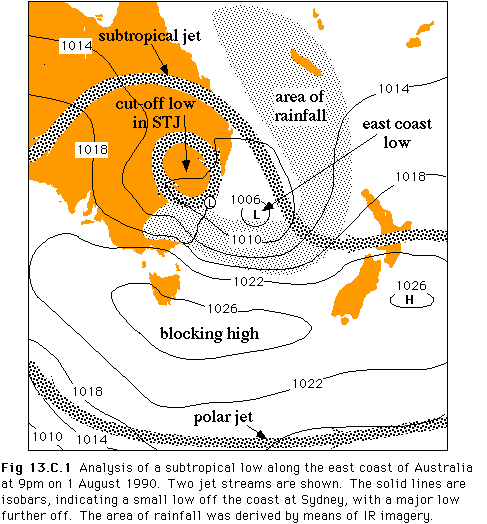|
E. Linacre and B. Geerts |
11/'97 |

An Australian east-coast lows, a type of a subtropical low (Section 13.4), is fairly rare but produces heavy rain along the coast as it tracks southward just offshore of southeast Australia (1). As discussed in Note 13.C, an east coast low is an extreme case of an easterly wave trough.
In the case illustrated in Fig 13.C.1, there were damaging coastal winds and rainfalls of up to 248mm within 24 hours. The heavy rain is a result of onshore southeasterly maritime winds, high sea-surface temperatures, orographic lifting, upper-tropospheric divergence associated with a deep trough in the subtropical jet, and occasionally deep convection.
Examination of rainfall records and surface weather analyses between 1958 - 1992 (2) has shown 80 east-coast lows, i.e. 2.3 events per year. This study defined an east-coast low as follows: the low has to remain close to the coast on a southward track, for at least 24h, and the highest daily rainfall during the storm at affected coastal stations has to exceed the normal monthly-mean daily total by a factor of 10. Tropical cyclones are excluded.
East-coast lows are most common in winter, when the lower atmosphere along the east coast is more baroclinic, on account of the warm east Australian current, and because the subtropical jet is stronger and closer to the equator. According to (2), east-coast lows are more common when the surface-temperature anomaly within 50 km of the coastline is strongly positive (> 4 K). Also, the data suggest a preference for east-coast lows to form when the Southern Oscillaton Index changes from an extremely low value (El Niño) to an extremely high one (La Niña). During La Niña conditions, individual east-coast low events on average produce more rain along the southeast coast. A slight increase in annual frequency of east-coast lows was observed during the study period.
References
(1) Holland, G.J., A.H. Lynch and L.M. Leslie 1987. Australian east-coast cyclones. Mon. Weather Rev., 115, 3024-53.
(2) Hopkins, L.C. & G.J. Holland 1997. Australian heavy-rain days and associated east coast cyclones 1958-92. J. Climate, 10, 621-35.